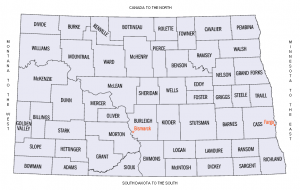[breadcrumb]
 South Dakota has several naturally-occurring deposits of asbestos. Many are located on the state’s western border with Wyoming. One specific location is a few miles south of Mount Rushmore in Keystone at Homestake Gold Mine. When these deposits were mined or are disturbed, asbestos fibers can become airborne and be inhaled by individuals in the surrounding areas, leading to mesothelioma and other respiratory problems.
South Dakota has several naturally-occurring deposits of asbestos. Many are located on the state’s western border with Wyoming. One specific location is a few miles south of Mount Rushmore in Keystone at Homestake Gold Mine. When these deposits were mined or are disturbed, asbestos fibers can become airborne and be inhaled by individuals in the surrounding areas, leading to mesothelioma and other respiratory problems.
Even though there are fewer asbestos-related deaths in the state, certain occupations placed workers at risk for possible exposure to asbestos that could have compromised their health. One of the industries most associated with asbestos exposure is power plants. The state has four hydroelectric power plants where former workers may have been exposed to asbestos. These types of plants often used asbestos in turbines that were often a component of the plant. Plant workers could have breathed in toxic asbestos fibers when they became airborne.
Another industry often associated with asbestos exposure is mechanic and automotive repair. Asbestos was often used in brakes and clutches to prevent friction. Individuals who worked around these automotive reports could have inhaled asbestos fibers.
Military operations are also associated with possible threat of asbestos because the material was used in the construction of many barracks, sleeping quarters, mess halls and other locations throughout army bases. Additionally, asbestos was often used in weapons and vehicles. Ellsworth Air Force Base is the state’s second largest employer. Service personnel could have been exposed to asbestos after years of prolonged use of the heat-resistant material.
 South Dakota Mesothelioma Diagnoses
South Dakota Mesothelioma Diagnoses
South Dakota is ranked 41st in the nation for the number of mesothelioma and asbestosis incidents. Between 1999 and 2015, at least 91 South Dakota residents were diagnosed with mesothelioma. There were over 17 South Dakota residents who were diagnosed with asbestosis and over 376 South Dakota residents who were diagnosed with from non-mesothelioma lung cancer. Most diagnoses have come from the following locations: Sioux Falls, Aberdeen, Rapid City, Mitchell, Brookings, Yankton, and Watertown
 South Dakota Asbestos Laws
South Dakota Asbestos Laws
South Dakota has laws that may impact mesothelioma litigation, including when the claim must be filed and what the plaintiff must prove. Some of these laws include:
Statute of Limitations
The statute of limitations is the time in which a plaintiff can file a claim against a negligent party. If this time limit passes, the claim can be barred because the plaintiff took too long to pursue the cause of action. In South Dakota, the statute of limitations to bring forth a case based on asbestos exposure is three years from the date of the victim’s diagnosis. If the individual dies from mesothelioma or another asbestos-related condition, the statute of limitations is three years from the date of death.
Court Exposure Standard
A plaintiff that pursues a case in South Dakota must show that the defendant’s product or conduct proximately caused his or her injury. This requires showing that the defendant’s product was used in the workplace, the employer or manufacturer failed to warn the plaintiff of the dangers of asbestos in the product and that the exposure to this product was more likely than not the cause of the plaintiff’s development of mesothelioma or another asbestos-related disease.
South Dakota State Asbestos Regulatory Agencies and Regulations
On the federal level, the United States Environmental Protection Agency is responsible for developing and enforcing regulations that are required to protect the general public from exposure to airborne contaminants such as asbestos that are associated with causing harm to residents’ health. Additionally, the Occupational Safety and Health Administration implements and enforces laws related to asbestos exposure in the workplace.
On the state level, the South Dakota Department of Environment & Natural Resources is primarily responsible for implementing and enforcing regulations related to asbestos. There are several laws in the state regarding abatement and administrative rules regarding emission standards and for asbestos when properties are being renovated or demolished.
These administrative rules include the following definitions:
- Asbestos – The asbestiform varieties of serpentine (chrysotile), riebeckite (crocidolite), cummungtonite-grunerite (amosite), anthophyllite, actinolite, and tremolite.
- Asbestos-containing material or “ACM” – Material containing more than one percent asbestos by area;
- Friable asbestos-containing material (ACM) – Friable asbestos-containing material is any material containing more than one percent asbestos as determined using the method specified in Appendix A, Subpart F, 40 C.F.R. Part 763 Section 1, Polarized Light Microscopy (July 1, 1993), which has been applied on ceilings, walls, structural members, piping, duct work, or any other part of a building and which, when dry, can be crumbled, pulverized, or reduced to powder by hand pressure. The term includes previously nonfriable asbestos-containing material after it becomes damaged to the extent that when dry it may be crumbled, pulverized, or reduced to powder by hand pressure. If the asbestos content is less than 10 percent as determined by a method other than point counting by polarized light microscopy (PLM), the asbestos content shall be verified by point counting using PLM.
South Dakota’s asbestos laws apply when contractors remodel or demolish public or commercial buildings, as well as when work applies to private residences and apartment buildings that have five or more dwellings. Before commencing this work, the South Dakota Department of Environment & Natural Resources must receive notification at least 10 working days before the project is commenced.
South Dakota Asbestos Site Exposure List
Exposure to asbestos has commonly been linked to industrial, manufacturing and construction sectors. Industrial machinery often used asbestos as an insulator. As machinery aged, asbestos fibers often became released as the machinery deteriorated. Other occupations in South Dakota that are linked to an increased risk of asbestos exposure include industrial engineers, mechanics, military personnel, construction workers, insulation contractors, power plant workers and teachers. Some South Dakota jobsites with a potential link to asbestos exposure include the following:
- Ellsworth Air Force Base – Box Elder
- Rapid City Air Force Base – Rapid City
- Stanley County Elementary School – Fort Pierre
- South Dakota State University – Brookings
- Belle Fourche Police Headquarters – Belle Fourche
- Homestake Gold Mine – Lead
- Big Bend Dam – Buffalo and Lyman County
- Fort Randall Dam – Gregory and Charles Mix County
- Gavins Point Dam – Yankton
- Oahe Dam – Hughes and Stanley County
- Pathfinder Power Plant – Sioux Falls
- Angus Anson Power Plant – Sioux Falls
- Black Hills Generation – Rapid City
South Dakota Asbestos Bankruptcy Trusts
Many asbestos companies were sued by consumers and employees after the dangers of asbestos were linked to their products and the work environment. Many of these companies faced hundreds or thousands of lawsuits due to liability stemming from their products. As a result, they often filed bankruptcy. Some of these companies established special asbestos trusts that provided compensation to claimants for the damages they suffered from their products. When an asbestos trust is available, a claimant may be able to make a claim without going through the typical process of litigation.
There are no asbestos trusts that were formed by companies headquartered in South Dakota or that are administered by trustees in South Dakota. However, many of the companies that formed asbestos trusts operated in multiple states or employed individuals in South Dakota. A claimant may have a claim against one of these asbestos trusts. A South Dakota mesothelioma lawyer can explain if one of these trusts is available.
South Dakota Mesothelioma and Asbestos Lawsuits
Given the lower instance of mesothelioma in the state, there are few asbestos cases filed in South Dakota. Many lawsuits are resolved before trial. In the case of settlements, many claimants sign a confidentiality agreement that prevents them from discussing the case or saying how much the settlement was for.
South Dakota has played a pivotal part in asbestos cases related to talc powder. These cases typically allege that a person suffered ovarian cancer or another serious medical condition due to prolonged use of baby powder manufactured by companies such as Johnson & Johnson. Some of these claims state that asbestos was in the powder and that consumers were not made aware of the dangers of using the product.
The first case of this nature was filed by a South Dakota woman. The South Dakota jury awarded her no damages, but the case paved the way for other cases of this nature, including a $72 million verdict in favor of a family of a woman who died from ovarian cancer linked to her use of baby powder and a $4.69 billion victory for 22 women who suffered due to the use of the baby powder product.
In another case a South Dakota resident had received a a $55 million verdict in 2016 in her favor that was awarded by a Missouri court for compensatory and punitive damages after she developed ovarian cancer. However, this case was ultimately reversed in 2017 by the Missouri Court of Appeals on the basis of lack of jurisdiction due to a Supreme Court ruling that held that asbestos cases must be filed in states where the company is based or the injuries occurred.
South Dakota Mesothelioma Lawyers
Given the lower rate of mesothelioma diagnoses in the state, most of the mesothelioma lawyers who serve South Dakota are part of national firms. If you have been diagnosed with mesothelioma contact our law firm today.
